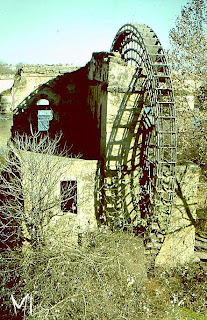In 2004, I went on a trip to Syria, together with Arabic scholars
and archeologists from Portugal. It was nice to find such a peaceful country in
stark contrast with Iraq.
Syria’s treasures have crossed over the centuries and they show us the influence
the Fertile Crescent has had on our Western civilization.
While in Syria, I had the opportunity to be ‘introduced’ to
the Epic of Gilgamesh that dates to the days of the Sumerians who surprise us
with their inventiveness, their cuneiform writing. Mind you, it was in the 4th
millennium BC.
The search for eternal life, the paradise myth, the diluvia and the Noah’s
Ark, the first report of the resurrection and the image portraying Saint George
are parts of the epics inherited from the Hebrews. They became Bible stories that the
Christians know so well.
The first Islamic dynasty, the Omayyad, elected the Great Syria as their
kingdom and Damascus its respective capital.
The next Islamic dynasty, the Abassids, rebelled against the Omayyad. At
first, they did it on Persian territory but later they conquered Damascus. Abd-al-Rahman, the last Omayyad prince, managed to escape
the massacre, and fled to the Iberian peninsula where he established a brilliant dynasty in Al-Aldalus. .

Damascus mosque (786 AC) was the model for the Cordoba mosque at
Al-Andalus.
Syria wooden norias - huge water wheels up to 20 meters in
diameter built on the Orontes River - developed in the Byzantine period.
Nowadays, we can still see similar ones in Al-Andalus, mainly in Cordoba, where
they are called noras.
And now Syria is at war! So much of our Past is over there and nobody knows
how longer it will survive…





















